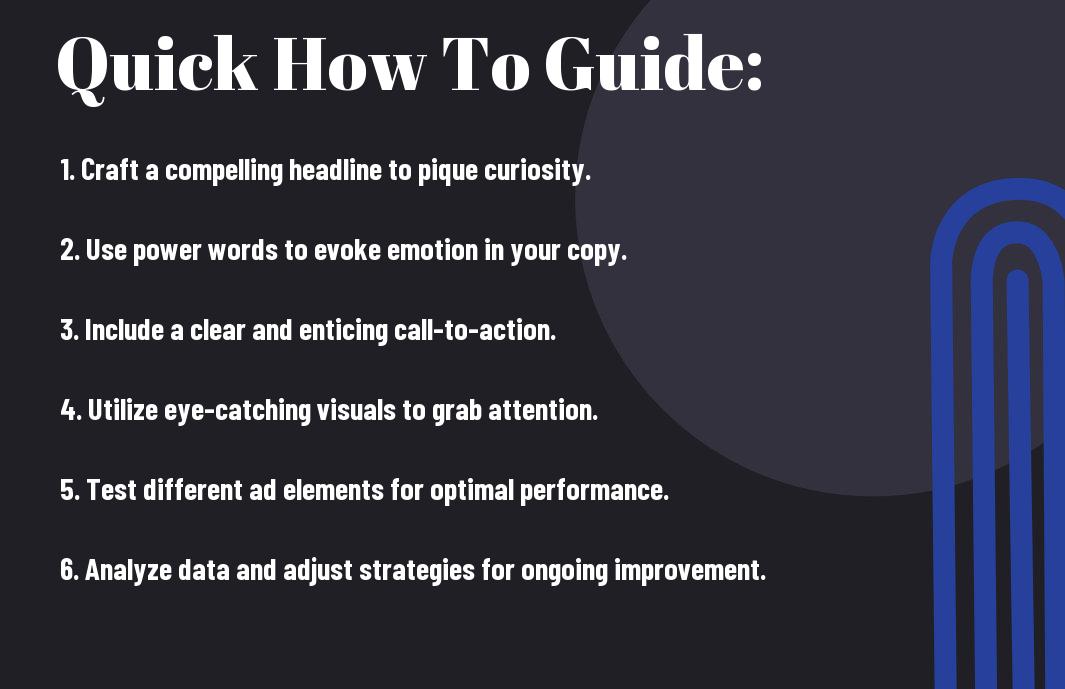Mastering Manipulation – A How-To Guide for Boosting Your CTR
Prepare to probe deep into the realms of manipulation with our comprehensive guide on boosting your Click-Through Rate (CTR). In the competitive landscape of digital marketing, mastering the art of CTR manipulation can be the difference between success and obscurity. If you are ready to unlock the secrets to driving more traffic and achieving higher conversion rates, this guide is important reading.
Learn the intricate tactics and strategies that experts use to manipulate CTR and gain a competitive edge in the online arena. Discover the power of psychological triggers, compelling copywriting, and strategic placement to maximize your CTR. Dive into our in-depth insights and step-by-step instructions to take your digital marketing game to the next level. For a more detailed guide, check out A Comprehensive Guide to CTR Manipulation – Clickass.

Understanding Click-Through Rates
Defining CTR and Its Importance in Digital Marketing
The Click-Through Rate (CTR) is a metric used in digital marketing to measure the number of clicks advertisers receive on their ads per number of impressions. It is calculated by dividing the total number of clicks by the total number of impressions and multiplying by 100 to get a percentage.
CTR is a crucial metric in digital marketing as it indicates the effectiveness of your marketing campaigns in engaging your target audience. A high CTR signifies that your ad is relevant and compelling enough to attract clicks, leading to increased traffic to your website or landing page.
The Relationship Between CTR and Conversion Rates
The relationship between CTR and Conversion Rates is intricate but necessary in understanding the overall success of your digital marketing efforts. While CTR measures the number of clicks your ad receives, conversion rates reveal the percentage of those clicks that result in a desired action, such as a purchase, sign-up, or download.
It is important to note that a high CTR does not always guarantee high conversion rates. Your ad may be enticing enough to attract clicks, but if your landing page or product offering fails to meet the expectations set by the ad, users are less likely to convert.
With a deeper understanding of the relationship between CTR and Conversion Rates, you can optimize your campaigns to not only attract clicks but also drive meaningful actions that lead to conversions, ultimately maximizing your ROI.
Mastering Manipulation – A How-To Guide for Boosting Your CTR
Improving your Click-Through Rate (CTR) is key to maximizing the effectiveness of your digital marketing efforts. In this chapter, we will examine into the crucial step of analyzing your current CTR to identify areas for improvement and develop a winning strategy.
How to Measure Your Existing Click-Through Rates
The first step in analyzing your CTR is to understand how to measure it accurately. You can calculate your CTR by dividing the number of clicks your ad or content receives by the number of times it was shown (impressions), then multiplying by 100 to get a percentage. This percentage indicates the effectiveness of your campaign in attracting clicks.
Once you have calculated your CTR, you can compare it to industry benchmarks to assess how well your campaigns are performing. Tools like Google Analytics can provide valuable insights into your CTR, helping you track progress over time and make informed decisions to enhance your marketing efforts.
Identifying Strengths and Weaknesses in Your Current Strategy
Pertaining to analyzing your CTR, identifying the strengths and weaknesses of your current strategy is paramount. By measuring the performance of each element in your campaign – from ad copy to targeting criteria – you can pinpoint what is working well and what needs improvement.
By analyzing your existing data, you can uncover patterns, trends, and outliers that provide valuable insights into your audience’s preferences and behavior. This information is vital for optimizing your campaigns to increase engagement and drive conversions effectively.
The Psychology Behind Clicks
Now, let’s research into the intricate world of the psychology behind why users click on certain links, and how you can master these psychological triggers to boost your click-through rate (CTR).
Cognitive Triggers That Encourage User Engagement
Behind every click lies a cognitive trigger that sparks user engagement. These triggers can range from the use of compelling visuals, emotional storytelling, to the power of social proof. By understanding the cognitive triggers that influence user behavior, you can craft your content in a way that resonates with your audience and compels them to click.
Creating a Sense of Urgency and Curiosity
Triggers that evoke a sense of urgency and curiosity are particularly effective in driving clicks. Phrases like “Limited time offer,” “Act now,” or “Discover the secret” create a sense of FOMO (fear of missing out) and intrigue, prompting users to click to satisfy their curiosity or avoid missing out on an opportunity.
The key to effectively creating a sense of urgency and curiosity is to strike a balance between providing enough information to spark interest while leaving just enough unsaid to pique curiosity and drive clicks. This delicate balance keeps users engaged and eager to learn more.
The psychology behind user clicks is a powerful tool in the hands of marketers and content creators. By understanding the cognitive triggers and leveraging the sense of urgency and curiosity, you can significantly boost your CTR and drive traffic to your desired destination.Crafting Compelling Content
Your digital marketing success heavily relies on your ability to create compelling content that not only attracts but also engages your target audience. In this chapter, we will examine into the art of crafting attention-grabbing headlines and writing effective descriptions that drive clicks and conversions.
How to Develop Headlines That Grab Attention
For any piece of content, the headline serves as the first point of contact with your audience. It’s crucial to create headlines that not only intrigue but also compel users to click through. To achieve this, consider using strong action verbs, posing questions, or creating a sense of urgency. Emphasize the most important details and make sure your headline clearly conveys the value or benefit the user will gain by clicking on your content.
When crafting headlines, keep in mind the power of emotional triggers such as curiosity, fear, or excitement. By tapping into these emotions, you can make your headlines more compelling and increase the chances of users engaging with your content. Experiment with different headline structures and formats to see what resonates best with your audience.
Tips for Writing Effective Descriptions
To complement your compelling headlines, your content descriptions play a vital role in enticing users to click through. Use descriptions to provide a brief overview of what users can expect from your content. Focus on highlighting the key benefits, solutions, or outcomes users will gain by engaging with your content.
- Use power words to evoke emotions and create a sense of urgency.
- Keep descriptions concise and to the point to maintain user interest.
- Include relevant keywords to improve search visibility and attract the right audience.
To further enhance the effectiveness of your descriptions, incorporate calls-to-action that prompt users to take a specific action, such as clicking a link or signing up for a newsletter. After all, a well-crafted description can significantly impact the click-through rate and engagement levels of your content.
More Information on Tips for Writing Effective Descriptions
To truly optimize your descriptions for maximum impact, it’s important to focus on clarity, relevance, and value. Remember that users skim through content quickly, so make sure your descriptions are clear and concise. Including relevant keywords will also help improve search visibility and attract the right audience. After all, the ultimate goal is to provide value to your users and encourage them to take action.
- Clarity: Ensure your descriptions are clear and easy to understand.
- Relevance: Make sure your descriptions are relevant to the content and user intent.
- Value: Communicate the benefits and value users will gain from engaging with your content.
Headlines and descriptions are the gateways to your content, and mastering the art of crafting compelling copy can significantly impact the success of your digital marketing efforts. By incorporating these tips and strategies into your content creation process, you can enhance your CTR, drive more traffic to your website, and ultimately boost your conversion rates.
Visual Elements That Enhance CTR
Tips for Designing Eye-Catching Thumbnails and Images
Keep in mind that thumbnails and images are often the first things your audience sees when they encounter your content. To make them stand out and entice clicks, ensure they are visually appealing and make the viewer curious to learn more.
When designing thumbnails and images, remember to use high-quality visuals that are relevant to your content. Incorporate eye-catching colors and compelling graphics that will grab the viewer’s attention. Adding text overlays can also be effective in conveying important information or a call-to-action.
- High-quality visuals are key to attracting attention.
- Utilize compelling graphics to enhance engagement.
- Text overlays can convey important messages effectively.
How-to Use Colors and Fonts to Influence Click Behavior
Fonts and colors play a crucial role in influencing click behavior. The right combination can evoke specific emotions and perceptions in your audience, ultimately impacting their decision to click on your content. When choosing colors, opt for hues that resonate with your brand and evoke the desired emotional response in viewers.
Recognizing the importance of fonts is crucial as well. Select fonts that are legible and reflect your brand’s tone and personality. Consistency in font choice across your content can help establish a strong visual identity and make your brand more recognizable to your audience.
It is vital to experiment with different color schemes and font styles to determine what works best for your content. Testing various combinations and analyzing the click-through rates can provide valuable insights into what resonates with your audience and drives engagement. Take the time to refine your visual elements to optimize your CTR and maximize the impact of your content.
Technical Factors Affecting CTR
To optimize your click-through rate (CTR), you need to pay attention to various technical factors that can impact the performance of your online content. By understanding these key elements and how they affect user behavior, you can strategically enhance your CTR and boost your digital marketing efforts. Knowing the technical nuances that influence CTR is crucial for creating successful online campaigns.
Mobile Optimization: Ensuring Accessibility Across Devices
For maximizing your CTR, it is crucial to ensure that your content is accessible across all devices, especially mobile phones and tablets. With the increasing use of mobile devices for browsing, a responsive design that adapts to different screen sizes and resolutions is critical for engaging mobile users effectively. This level of optimization can significantly impact your CTR and overall user engagement.
Loading Times and Their Impact on User Engagement
An important technical factor that greatly influences CTR is the loading time of your web pages. Slow-loading pages can lead to a higher bounce rate and lower CTR, as users are less likely to wait for content to load. To improve user experience and increase CTR, it is crucial to optimize loading times by compressing images, minimizing server requests, and utilizing caching mechanisms.
Impact: Slow-loading pages can have a significant negative impact on user engagement and CTR, making it imperative to prioritize website speed optimization in your digital strategy.
The Role of Meta Tags in Search Visibility and CTR
Accessibility to search engines is key to improving CTR, and meta tags play a crucial role in communicating crucial information about your content to search engine algorithms. By optimizing your meta tags with relevant keywords, descriptive titles, and compelling meta descriptions, you can enhance your search visibility and attract more clicks from users.
To maximize the effectiveness of meta tags, regularly review and update them to align with your SEO strategy and ensure they accurately reflect the content of your web pages. This ongoing optimization can significantly impact your CTR and overall online performance.
Testing and Tweaking for CTR Optimization
How-to Implement A/B Testing for CTR Improvement
Not all ads or marketing strategies will resonate with your target audience. That’s why it’s crucial to implement A/B testing to determine what works best for optimizing click-through rates (CTR). With A/B testing, you can create two versions of an ad or marketing campaign and show them to different segments of your audience. By analyzing which version performs better in terms of CTR, you can identify what resonates most effectively with your audience.
With A/B testing, you can test different elements such as headlines, call-to-action phrases, images, colors, and overall ad formats. Testing one element at a time will help you isolate which changes have the most significant impact on CTR, allowing you to make informed decisions to optimize performance.
Analyzing Results and Making Data-Driven Decisions
Testing is only the first step; analyzing the results is where the real magic happens. Testing allows you to gather data on what resonates with your audience, but it’s the analysis that uncovers insights that drive CTR optimization. Look at key metrics like CTR, conversion rates, bounce rates, and engagement levels to understand the impact of your changes.
Tweaking your ad or marketing strategies based on the data-driven insights you’ve gathered is crucial for continuous improvement. Make small, calculated adjustments to elements that have proven to boost CTR, and monitor the results closely. By consistently tweaking your approach based on data, you can incrementally improve your CTR and overall marketing performance.
Advanced Strategies for Boosting CTR
After mastering the basics of click-through rate (CTR) manipulation, it’s time to investigate into advanced strategies that can take your digital marketing efforts to the next level. By implementing these expert techniques, you can significantly boost your CTR and drive more traffic to your website.
| Personalization Techniques | Using Retargeting Campaigns |
| Increasing Relevance and Engagement | Improving CTR |
Personalization Techniques to Increase Relevance and Engagement
An effective way to boost your CTR is by personalizing your content and ads to cater to the individual needs and preferences of your target audience. By segmenting your audience based on their behavior, demographics, and interests, you can create tailored messages that resonate with them on a deeper level. This level of personalization not only increases relevance but also enhances engagement, leading to higher click-through rates and conversion rates.
Another powerful personalization technique is dynamic content, where you display different content to users based on their past interactions with your website or previous purchases. This dynamic approach keeps your audience engaged and interested, prompting them to click through to learn more or make a purchase.
Using Retargeting Campaigns to Improve CTR
Using retargeting campaigns is a proven strategy for improving CTR and maximizing your marketing efforts. By targeting users who have previously visited your website but did not convert, you can re-engage them with personalized ads that remind them of your products or services. This reminder can be the push they need to click through and complete their purchase, boosting your CTR and driving conversions.
As a powerful tool in the digital marketer’s arsenal, retargeting allows you to stay top of mind with potential customers and guide them down the sales funnel. By strategically retargeting users with relevant ads based on their past interactions, you can significantly increase your chances of driving conversions and improving your overall CTR.
Leveraging Social Proof to Boost CTR
Unlike other marketing strategies, leveraging social proof can significantly boost your Click-Through Rate (CTR) by building trust with your audience. Social proof is a powerful psychological phenomenon where people tend to follow the actions of others when making decisions. By showcasing positive feedback from customers, you can learn more about CTR Manipulation (Why it’s IMPORTANT and how to do it).
How-to Incorporate Reviews and Testimonials Effectively
Leveraging customer reviews and testimonials on your website or in your advertisements is an effective way to build credibility and increase your CTR. When potential customers see positive feedback from others, they are more likely to trust your brand and click through to learn more. Make sure to highlight specific details or success stories that resonate with your target audience to maximize the impact of social proof.
Encourage customers to leave reviews after a purchase by offering incentives or making the process quick and easy. Consider featuring reviews prominently on your landing pages or creating a dedicated section for testimonials to showcase the positive experiences of your satisfied customers.
Tips for Utilizing Influencer Endorsements and User-Generated Content
Content
- Collaborate with influencers in your industry to reach a wider audience and gain credibility.
Influencer marketing can be a game-changer when it comes to boosting your CTR. Partnering with influencers who align with your brand values can help you tap into their loyal followers and increase brand awareness. User-generated content, such as customer photos or testimonials, can also be a powerful tool to reinforce your brand’s trustworthiness and authenticity. Perceiving authenticity is crucial in today’s marketing landscape, and leveraging social proof from influencers and users can help you stand out from the competition.
Adapting to Platform-Specific CTR Strategies
All digital platforms are not created equal, and understanding how to tailor your click-through rate (CTR) strategies to different platforms is crucial for success. By adapting your approach to social media and search engines, you can maximize your CTR and drive more traffic to your website.
Maximizing Click-Through Rates on Social Media
ClickThrough rates on social media can be influenced by various factors such as engaging visuals, compelling copy, and the timing of your posts. To increase your CTR on social platforms like Facebook, Instagram, and Twitter, it’s important to create eye-catching content that resonates with your audience. Use high-quality images, videos, and interactive elements to grab users’ attention and encourage them to click through to your website.
Strategies for Enhancing CTR on Search Engines
An effective way to enhance your CTR on search engines is to optimize your meta tags and descriptions. Craft compelling and relevant meta titles and descriptions that include target keywords and accurately describe the content on your page. This will not only improve your search engine rankings but also entice users to click on your link when it appears in search results.
Maximizing your CTR on search engines also involves utilizing structured data markup to enhance your website’s appearance in search results. By including schema markup for rich snippets such as ratings, reviews, and product information, you can make your listing stand out and attract more clicks. Additionally, implementing a clear and enticing call-to-action in your meta description can prompt users to click through to your site.

How Can I Use Manipulation Techniques to Improve My SEO CTR?
To enhance your SEO CTR, consider optimizing SEO CTR manipulation techniques. Craft compelling meta descriptions and engaging titles for your content. Use persuasive language and incorporate eye-catching visuals. Experiment with A/B testing to see which approach yields the best results.
Ethical Considerations in Manipulation Techniques
Many digital marketers are familiar with the concept of manipulation techniques to boost Click-Through Rates (CTR) and engage audiences effectively. While these strategies can be powerful tools in the digital marketing arsenal, it is crucial to consider the ethical implications of using manipulation tactics. In this chapter, we research into the ethical considerations that marketers need to keep in mind when implementing manipulation techniques.
Balancing Persuasive Tactics with Transparency
Balancing persuasive tactics with transparency is key to ensuring that manipulation techniques are used ethically. While it is necessary to capture the audience’s attention and encourage them to take action, transparency in communication is equally important. Marketers should strive to strike a balance between using persuasive tactics to influence user behavior and providing transparent information about the product or service being promoted.
By maintaining transparency in their marketing efforts, businesses can build trust with their audience and cultivate long-term relationships. Consumers appreciate honesty and authenticity, and when they feel they are being manipulated or deceived, it can damage the brand’s reputation. Marketers should aim to be straightforward in their communication and avoid using misleading tactics that could erode trust.
The Importance of Maintaining User Trust and Adhering to Guidelines
Transparency is necessary for maintaining user trust and ensuring that manipulation techniques are used ethically. Marketers should be aware of industry guidelines and regulations governing marketing practices to avoid crossing ethical boundaries. Adhering to these guidelines not only protects the brand’s reputation but also builds credibility with consumers. It is crucial for marketers to prioritize the user’s best interests and respect their autonomy when using manipulation techniques.
Importance of maintaining user trust cannot be overstated in the digital age, where consumers have access to a wealth of information and are quick to spot dishonest tactics. By being transparent and ethical in their approach, marketers can build a loyal customer base and establish themselves as trustworthy sources of information and products.
Final Words
Considering all points discussed in this guide, it is clear that mastering manipulation techniques can significantly boost your click-through rate. By understanding the psychology behind user behavior and strategically implementing persuasive tactics, you can maximize the effectiveness of your online campaigns and drive more traffic to your website. Remember to continually monitor and adjust your strategies based on data and feedback to ensure optimal results.
Are the Strategies in “CTR Manipulation” Similar to “Mastering Manipulation”?
Yes, the strategies in “CTR manipulation” and “mastering manipulation” are similar in the sense that both aim to manipulate certain metrics for a desired outcome. In “CTR manipulation,” the goal is to boost your CTR rates, while in “mastering manipulation,” the focus is on mastering the tactics to achieve a specific outcome.
FAQ
Q: What is the importance of manipulating CTR?
A: Manipulating Click-Through Rate (CTR) is crucial as it directly impacts the visibility and ranking of your content on search engines.
Q: How can I effectively boost my CTR?
A: To boost your CTR, focus on crafting compelling meta titles, meta descriptions, and high-quality content that resonates with your target audience.
Q: Why is understanding user intent imperative for manipulating CTR?
A: Understanding user intent helps you tailor your content to meet the needs and expectations of your audience, increasing the likelihood of them clicking on your link.
Q: What role do keywords play in manipulating CTR?
A: Keywords are vital for SEO and CTR manipulation. Incorporate relevant keywords in your meta tags and content to attract users searching for specific topics.
Q: How does A/B testing contribute to improving CTR?
A: A/B testing allows you to compare different versions of your content to determine which ones perform better in terms of CTR. This data-driven approach helps you optimize your strategy for maximum results.
Q: What is the significance of mobile optimization in CTR manipulation?
A: With the increasing use of mobile devices, optimizing your content for mobile users is crucial for boosting CTR. Ensure your website is mobile-friendly and easy to navigate for better engagement.
Q: How can leveraging schema markup enhance CTR?
A: Schema markup helps search engines understand the content on your website better, leading to rich snippets in search results. These visually appealing snippets attract more clicks, thus improving your CTR.


